1990 VOLVO 240 fuel cap
[x] Cancel search: fuel capPage 6 of 143

Volvo 1990 240 Model
pg. 34Hood release, long load storage
pg. 35Rear/side view mirrors
pg. 36Interior light, sun roof, fuel tank cap
pg. 37Rear seat (wagon)
pg. 38Tailgate (wagon)
pg. 39Cargo compartment (wagon)
pg. 40Front seats
pg. 8 Instruments and Controls
pg. 9 Instruments and Controls
1 Air louver 23
2 Turn signals, cruise control 17, 24
3 Headlights, parking lights 15
4 Instruments, lights 15
file:///K|/ownersdocs/1990/1990_240/90240_01.htm (2 of 5)12/30/2006 8:\
25:01 AM
Page 8 of 143

Volvo 1990 240 Model
A Clock
B Direction indicator (green)
C Speedometer
In kilometers and miles per hour (U.S. models)
In kilometers per hour (Canadian models)
D Odometer
Total reading in miles (U.S. models)
Total reading in kilometers (Canadian models)
E Temperature gauge
The gauge pointer should remain inside the black range during normal \
operation.
If the pointer enters the red range repeatedly, check coolant level a\
nd fan belt tension. (See sections
titled "Cooling system and coolant") Warning: allow engine to cool before adding
fluid.
Do not continue to drive the car with the pointer in the red zone.
F Fuel gauge
The fuel tank capacity is approx 60 liters = 15.8 US gals. See "Fuel \
requirements".
G Clock reset knob
H Service reminder light
I Check engine (red)
J Alternator warning light (red)
K Oil pressure warning light (red)
Do not drive the car with this light on.
L SRS (Supplemental Restraint System)
M Trip odometer reset knob Push in to reset
file:///K|/ownersdocs/1990/1990_240/90240_01.htm (4 of 5)12/30/2006 8:\
25:01 AM
Page 73 of 143

Volvo 1990 240 Model
EMISSIONS
SYSTEM
MAINTENANCE
Engine oil and oil
filter R
R R R R R R R R R R R R
Cooling system
hoses and
connections I
Engine drive belts A I I
Torque manifold
nuts A
Valve clearance I I
Timing belt A R (3)
Vacuum fittings,
hoses and
connections I
Air cleaner filter R R
Idle RPM I
Fuel system cap,
tank, lines and
connections I
file:///K|/ownersdocs/1990/1990_240/90240_12.htm (4 of 7)12/30/2006 8:\
25:07 AM
Page 78 of 143
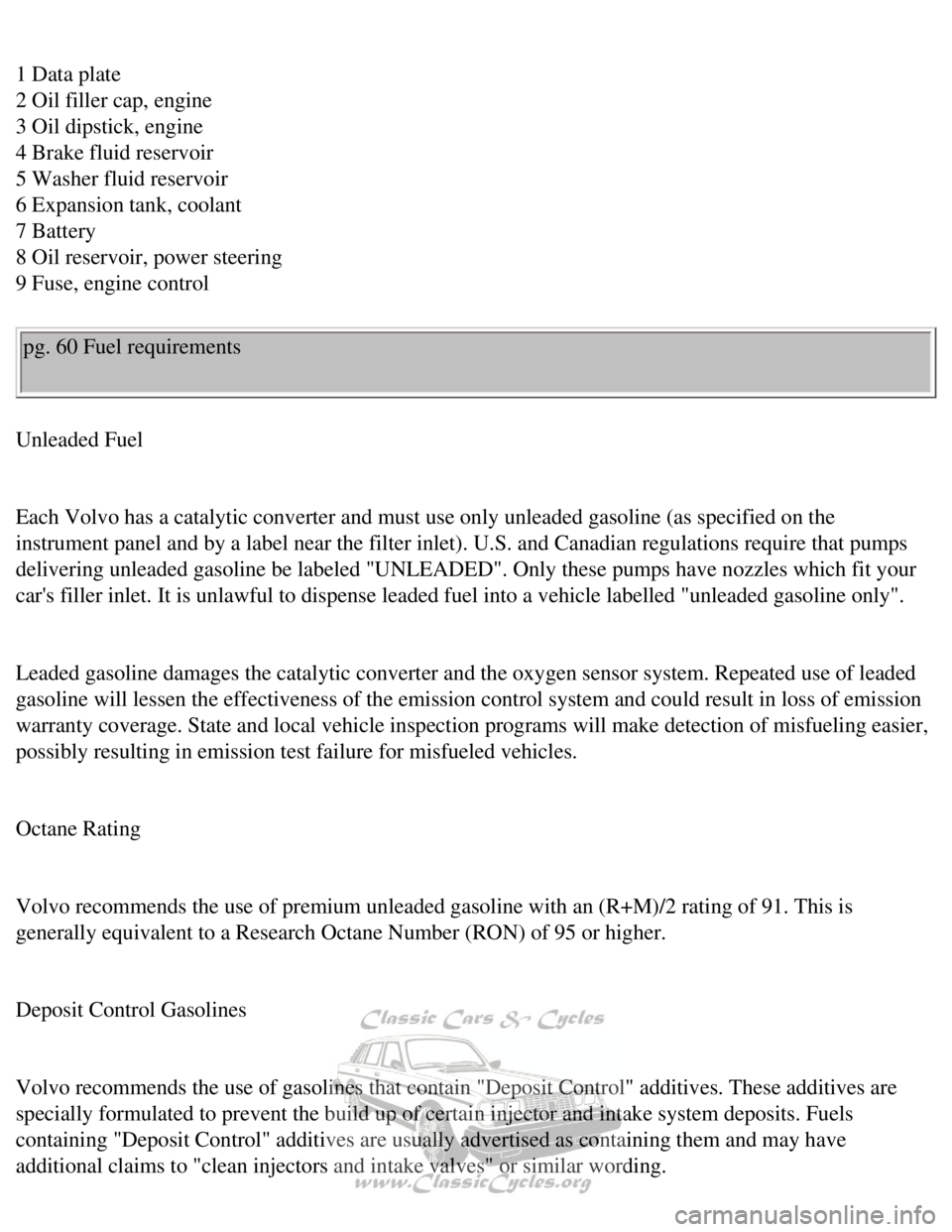
Volvo 1990 240 Model
1 Data plate
2 Oil filler cap, engine
3 Oil dipstick, engine
4 Brake fluid reservoir
5 Washer fluid reservoir
6 Expansion tank, coolant
7 Battery
8 Oil reservoir, power steering
9 Fuse, engine control pg. 60 Fuel requirements
Unleaded Fuel
Each Volvo has a catalytic converter and must use only unleaded gasoline\
(as specified on the
instrument panel and by a label near the filter inlet). U.S. and Canadi\
an regulations require that pumps
delivering unleaded gasoline be labeled "UNLEADED". Only these pumps hav\
e nozzles which fit your
car's filler inlet. It is unlawful to dispense leaded fuel into a vehicl\
e labelled "unleaded gasoline only".
Leaded gasoline damages the catalytic converter and the oxygen sensor sy\
stem. Repeated use of leaded
gasoline will lessen the effectiveness of the emission control system an\
d could result in loss of emission
warranty coverage. State and local vehicle inspection programs will make\
detection of misfueling easier,
possibly resulting in emission test failure for misfueled vehicles.
Octane Rating
Volvo recommends the use of premium unleaded gasoline with an (R+M)/2 \
rating of 91. This is
generally equivalent to a Research Octane Number (RON) of 95 or higher\
.
Deposit Control Gasolines
Volvo recommends the use of gasolines that contain "Deposit Control" add\
itives. These additives are
specially formulated to prevent the build up of certain injector and int\
ake system deposits. Fuels
containing "Deposit Control" additives are usually advertised as contain\
ing them and may have
additional claims to "clean injectors and intake valves" or similar word\
ing.
file:///K|/ownersdocs/1990/1990_240/90240_13.htm (2 of 9)12/30/2006 8:\
25:08 AM
Page 79 of 143
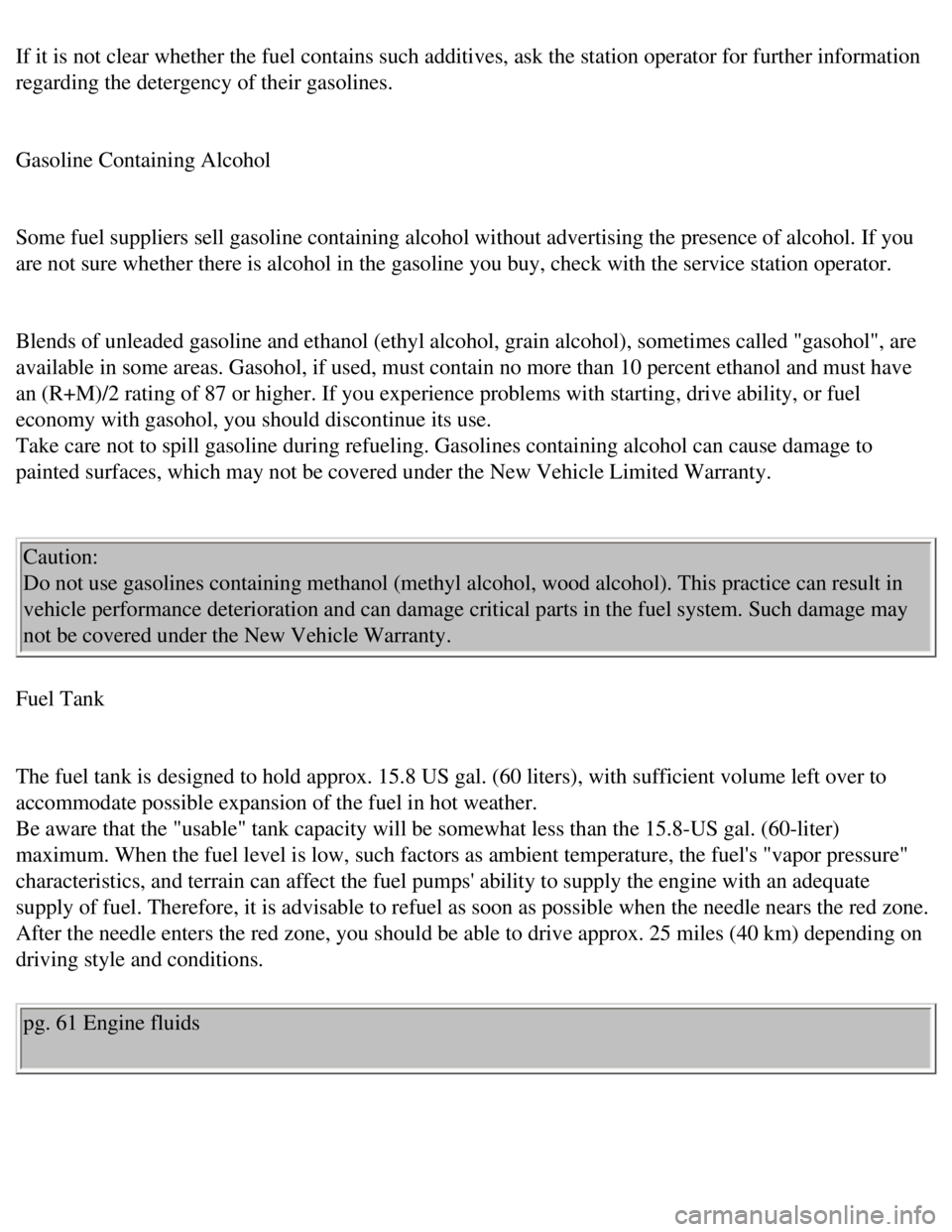
Volvo 1990 240 Model
If it is not clear whether the fuel contains such additives, ask the sta\
tion operator for further information
regarding the detergency of their gasolines.
Gasoline Containing Alcohol
Some fuel suppliers sell gasoline containing alcohol without advertising\
the presence of alcohol. If you
are not sure whether there is alcohol in the gasoline you buy, check wit\
h the service station operator.
Blends of unleaded gasoline and ethanol (ethyl alcohol, grain alcohol)\
, sometimes called "gasohol", are
available in some areas. Gasohol, if used, must contain no more than 10 \
percent ethanol and must have
an (R+M)/2 rating of 87 or higher. If you experience problems with sta\
rting, drive ability, or fuel
economy with gasohol, you should discontinue its use.
Take care not to spill gasoline during refueling. Gasolines containing a\
lcohol can cause damage to
painted surfaces, which may not be covered under the New Vehicle Limited\
Warranty.
Caution:
Do not use gasolines containing methanol (methyl alcohol, wood alcohol)\
. This practice can result in
vehicle performance deterioration and can damage critical parts in the f\
uel system. Such damage may
not be covered under the New Vehicle Warranty.
Fuel Tank
The fuel tank is designed to hold approx. 15.8 US gal. (60 liters), wi\
th sufficient volume left over to
accommodate possible expansion of the fuel in hot weather.
Be aware that the "usable" tank capacity will be somewhat less than the \
15.8-US gal. (60-liter)
maximum. When the fuel level is low, such factors as ambient temperature\
, the fuel's "vapor pressure"
characteristics, and terrain can affect the fuel pumps' ability to suppl\
y the engine with an adequate
supply of fuel. Therefore, it is advisable to refuel as soon as possible\
when the needle nears the red zone.
After the needle enters the red zone, you should be able to drive approx\
. 25 miles (40 km) depending on
driving style and conditions.
pg. 61 Engine fluids
file:///K|/ownersdocs/1990/1990_240/90240_13.htm (3 of 9)12/30/2006 8:\
25:08 AM
Page 82 of 143
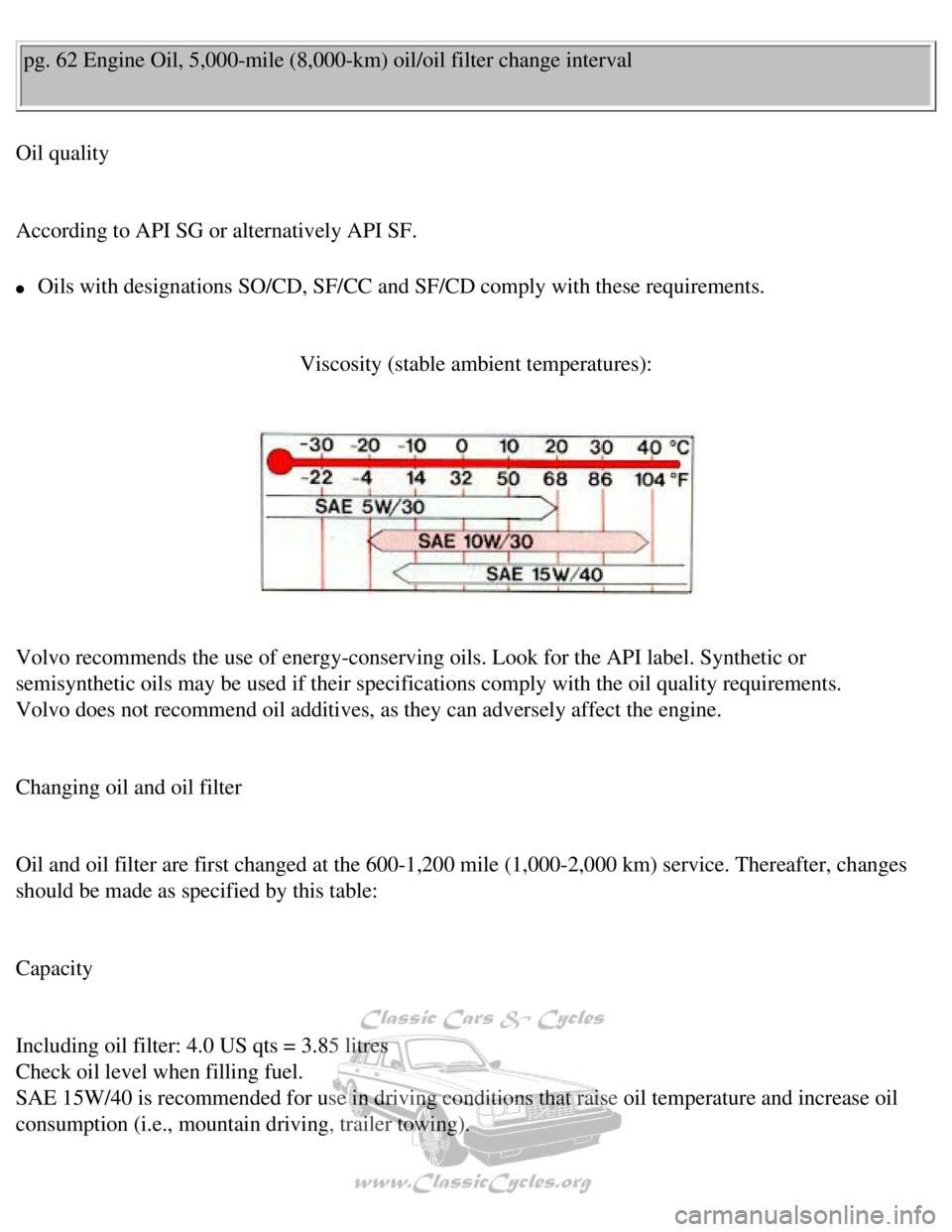
Volvo 1990 240 Model
pg. 62 Engine Oil, 5,000-mile (8,000-km) oil/oil filter change interva\
l
Oil quality
According to API SG or alternatively API SF.
l Oils with designations SO/CD, SF/CC and SF/CD comply with these requirem\
ents.
Viscosity (stable ambient temperatures):
Volvo recommends the use of energy-conserving oils. Look for the API lab\
el. Synthetic or
semisynthetic oils may be used if their specifications comply with the o\
il quality requirements.
Volvo does not recommend oil additives, as they can adversely affect the\
engine.
Changing oil and oil filter
Oil and oil filter are first changed at the 600-1,200 mile (1,000-2,000\
km) service. Thereafter, changes
should be made as specified by this table:
Capacity
Including oil filter: 4.0 US qts = 3.85 litres
Check oil level when filling fuel.
SAE 15W/40 is recommended for use in driving conditions that raise oil t\
emperature and increase oil
consumption (i.e., mountain driving, trailer towing).
file:///K|/ownersdocs/1990/1990_240/90240_13.htm (6 of 9)12/30/2006 8:\
25:08 AM
Page 88 of 143
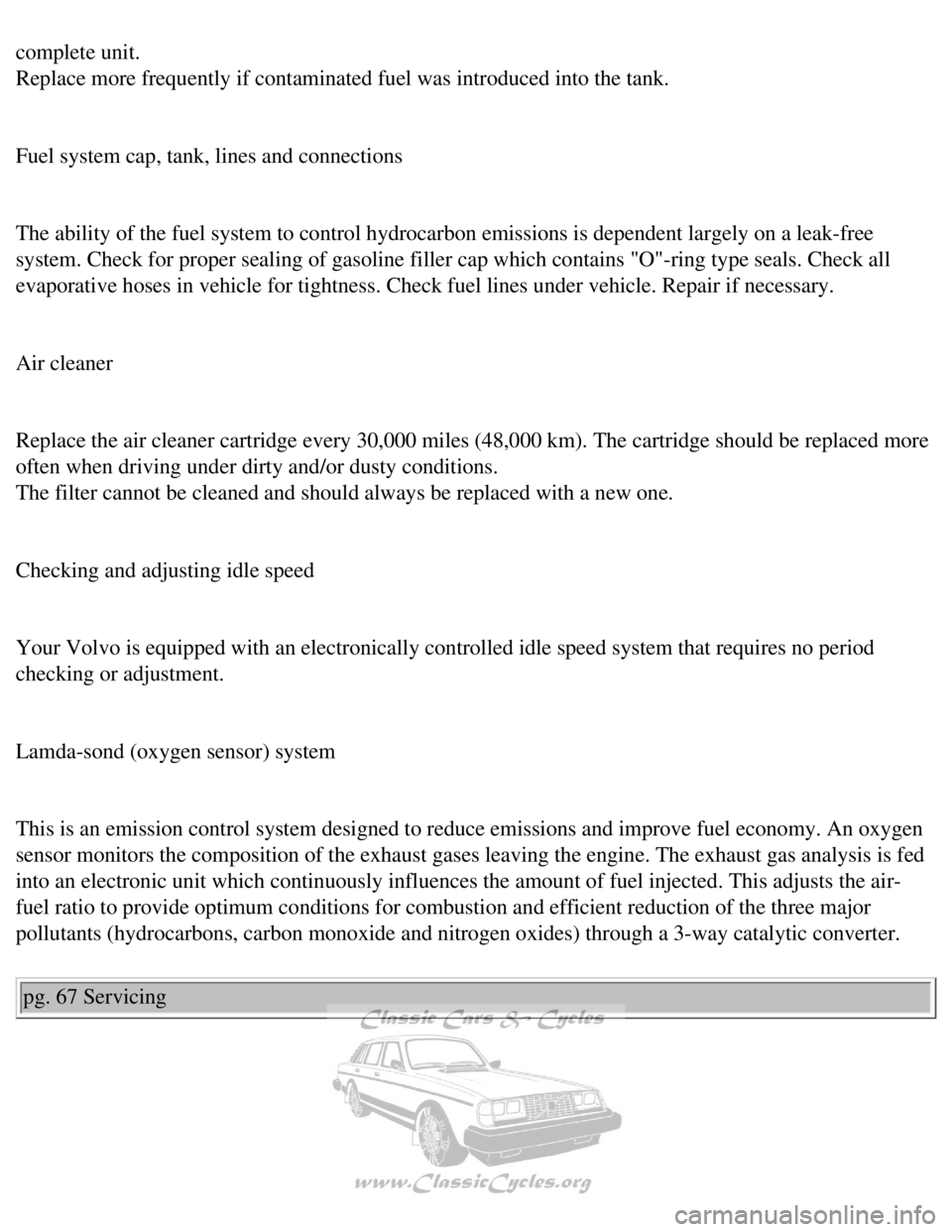
Volvo 1990 240 Model
complete unit.
Replace more frequently if contaminated fuel was introduced into the tan\
k.
Fuel system cap, tank, lines and connections
The ability of the fuel system to control hydrocarbon emissions is depen\
dent largely on a leak-free
system. Check for proper sealing of gasoline filler cap which contains "\
O"-ring type seals. Check all
evaporative hoses in vehicle for tightness. Check fuel lines under vehic\
le. Repair if necessary.
Air cleaner
Replace the air cleaner cartridge every 30,000 miles (48,000 km). The \
cartridge should be replaced more
often when driving under dirty and/or dusty conditions.
The filter cannot be cleaned and should always be replaced with a new on\
e.
Checking and adjusting idle speed
Your Volvo is equipped with an electronically controlled idle speed syst\
em that requires no period
checking or adjustment.
Lamda-sond (oxygen sensor) system
This is an emission control system designed to reduce emissions and impr\
ove fuel economy. An oxygen
sensor monitors the composition of the exhaust gases leaving the engine.\
The exhaust gas analysis is fed
into an electronic unit which continuously influences the amount of fuel\
injected. This adjusts the air-
fuel ratio to provide optimum conditions for combustion and efficient re\
duction of the three major
pollutants (hydrocarbons, carbon monoxide and nitrogen oxides) through\
a 3-way catalytic converter. pg. 67 Servicing
file:///K|/ownersdocs/1990/1990_240/90240_14.htm (3 of 7)12/30/2006 8:\
25:08 AM
Page 99 of 143
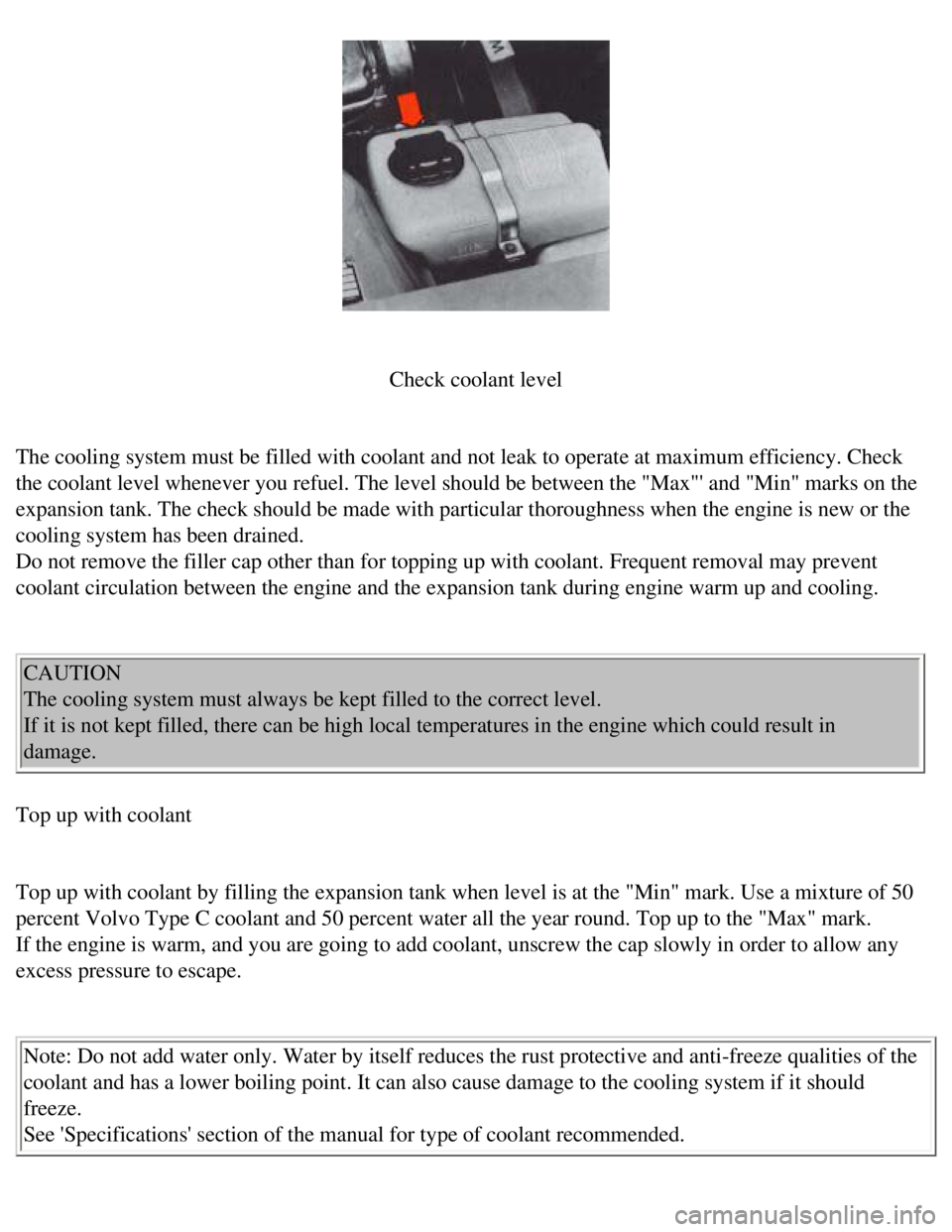
Volvo 1990 240 Model
Check coolant level
The cooling system must be filled with coolant and not leak to operate a\
t maximum efficiency. Check
the coolant level whenever you refuel. The level should be between the "\
Max"' and "Min" marks on the
expansion tank. The check should be made with particular thoroughness wh\
en the engine is new or the
cooling system has been drained.
Do not remove the filler cap other than for topping up with coolant. Fre\
quent removal may prevent
coolant circulation between the engine and the expansion tank during eng\
ine warm up and cooling.
CAUTION
The cooling system must always be kept filled to the correct level.
If it is not kept filled, there can be high local temperatures in the en\
gine which could result in
damage.
Top up with coolant
Top up with coolant by filling the expansion tank when level is at the "\
Min" mark. Use a mixture of 50
percent Volvo Type C coolant and 50 percent water all the year round. To\
p up to the "Max" mark.
If the engine is warm, and you are going to add coolant, unscrew the cap\
slowly in order to allow any
excess pressure to escape.
Note: Do not add water only. Water by itself reduces the rust protective\
and anti-freeze qualities of the
coolant and has a lower boiling point. It can also cause damage to the c\
ooling system if it should
freeze.
See 'Specifications' section of the manual for type of coolant recommend\
ed.
file:///K|/ownersdocs/1990/1990_240/90240_15.htm (7 of 10)12/30/2006 8\
:25:09 AM